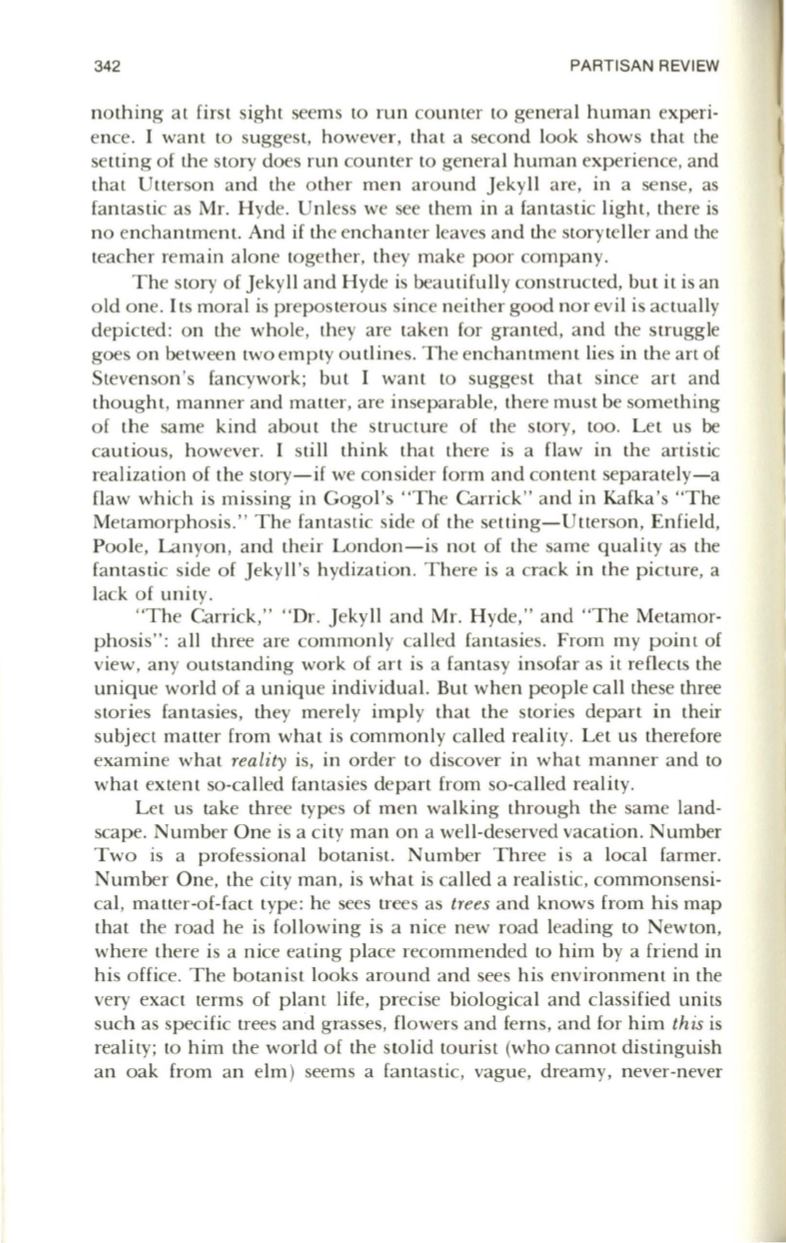
342
PARTISAN REVIEW
nothing at first sight seems to run counter
to
general human experi–
ence. I want to suggest, however, that a second look shows that the
setting of the story does run counter to general human experience, and
that Utterson and the other men around Jekyll are, in a sense, as
fantastic as Mr. Hyde. Unless we see them in a fantastic light, there is
no enchantment. And if the enchanter leaves and the storyteller and the
teacher remain alone together, they make poor company .
The story of Jekyll and Hyde is beautifully constructed, but it is an
old one. Its moral is preposterous since neither good nor evil is actually
depicted: on the whole, they are taken for granted, and the struggle
goes on between two empty outlines. The enchantment lies in the art of
Stevenson's fancywork; but I want to suggest that since art and
thought, manner and matter, are inseparable, there must be something
of the same kind about the structure of the story, too. Let us be
cautious, however. I still think that there is a flaw in the artistic
realization of the story-if we consider form and content separately-a
flaw which is missing in Gogol's "The Carrick" and in Kafka's "The
Metamorphosis." The fantastic side of the setting-Utterson, Enfield,
Poole, Lanyon, and their London-is not of the same quality as the
fantastic side of Jekyll's hydization. There is a crack in the picture, a
lack of unity.
"The Carrick," "Dr. Jekyll and Mr. Hyde," and "The Metamor–
phosis": all three are commonly called fantasies. From my point of
view, any outstanding work of an is a fantasy insofar as it reflects the
unique world of a unique individual. But when people call these three
stories fantasies, they merely imply that the stories depart in their
subject matter from what is commonly called reality. Let us therefore
examine what
reality
is, in order
to
discover in what manner and
to
what extent so-ca lled fantasies depart from so-called reality.
Let us take three types of men walking through the same land–
scape. Number One is a city man on a we ll-deserved vacation. Number
Two is a professional botanist. Number Three is a local farmer.
Number One, the city man, is what is ca lled a realistic, commonsensi–
cal, matter-of-fact type: he sees trees as
trees
and knows from his map
that the road he is following is a nice new road leading to Newton,
where there is a nice eating place recommended to him by a friend in
his office. The botanist looks around and sees his environment in the
very exact terms of plant life, precise biological and classified units
such as specific trees and grasses, flowers and ferns, and for him
this
is
reality; to him the world of the stolid tourist (who cannot distinguish
an oak from an elm) seems a fantastic, vague, dreamy, never-never


